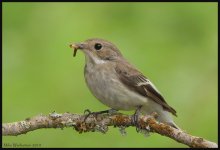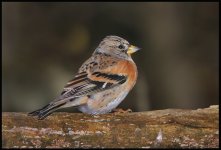I was sent an interesting article a while back about the effects of flash, thought i would share it here.
Flash Photography and the Visual System of Birds and Animals
Wednesday, March 31 2004
The use of artificial lighting to photograph animals is an area of controversy. To review this topic, a basic understanding of the retina is necessary.
BACKGROUND
The retina is comprised of rod cells for night and motion sensory information and cone cells for daylight and color vision. The ratio of rods and cones varies by species. Compared to mammals, birds have a greater number of cone cells allowing greater color perception and visual acuity in daylight. Nocturnal creatures, by comparison, have a greater rod-to-cone ratio which allows for better night vision.
In bright light, rod cells are bleached of rhodopsin, the photoreceptor pigment important for the translation of light energy into the electrical signals ultimately recognized by the occipital cortex of the brain. While the rods are inactive in bright light, the cone cells are responsible for translating light information into electrical signals. Going from bright to dark conditions, there is a period of dark adaptation required for the rod cells to “charge” and become functional. In nature, the change from light to dark is ordinarily gradual and the concurrent change from a cone driven electrical response to a signal originating primarily from rod cells occurs smoothly and without interruption of function.
PERMANENT DAMAGE
Phototoxic retinopathy, or permanent damage to retinal nerve cells as a result of light energy, has been studied in humans and other animals. Extreme unfiltered bright light, focused onto the retina through surgical microscope lenses has been documented to produce permanent retinal damage. To cause either microscopically evident or grossly visible lesions, the light must be held in focus on a single area of the retina for an extended period of time. This situation generally occurs in specialized surgery, when anesthetic agents prevent the movement of the eye. Operating microscopes for ophthalmology are now all equipped with specialized filters to prevent phototoxic retinopathy even with extended procedures.
Laser, by definition a highly focused beam of light energy, may produce retinal damage. In fact, in the treatment of diabetic retinopathy, retinal detachments and other diseases of the eye, laser is employed to purposefully burn selected areas of the retina. It is capable of doing this, even with very brief periods of exposure, because the light is highly focused. Therefore, when considering the possible damage to the retina by any light source, both its intensity and degree of focus must be assessed.
FLASH UNITS
Strobe lights used in on-camera flash units produce a very short duration burst of light, usually lasting only a small fraction of a second. Strobe lights are most often used at some distance from a subject and, even with flash extenders, the light is not focused, but diffused, upon reaching the subject. The inverse square law for light intensity indicates that the decay in light intensity occurs as the square of the distance from its source. Double the distance from the light source to the object and the object receives only one-quarter the intensity. In other words, the fall off in intensity is rapid as light leaves the strobe. Even at the source, the translucent plastic cover overlaying the flash element diffuses the light immediately.
For more than 20 years, researchers and clinicians have used the ERG test (electroretinogram) to study function and diseases of the retina. This test involves using a strobe light stimulator to record electrical signals originating from the rods and cones. Protocols vary by testing laboratories. The rod cells are usually tested by first dark-adapting the subject, i.e., placing the subject in a dark room from 5-20 minutes, and then subjecting the retina to a dim flash of light. The light is increased to full power and then flickered at 40Hz to isolate the cone cells for testing. The stimulator or strobe light is generally positioned within a few centimeters of the cornea for testing. Grass stimulator units produce diffuse light like a camera strobe, but of much greater intensity. For cone testing, the full power flash is flickered 40 times per second for several seconds in duration. Although the light is intense and positioned close to the subject, it is not highly focused and, consequently, does not permanently damage the retina.
EFFECTS OF FLASH
Nature photography subjects may be startled by a sudden unexpected burst of light; some may depart because of it, others may continue what they were doing and may not even appear reactive to subsequent use of flash. Light intensity, degree of focus, and ambient light are all factors when considering possible impact on visual acuity.
Fill-flash involves the balance of ambient and artificial lighting. In situations when fill-flash is used, cone cells are active, and they are designed to work in all but dim light. Because of this, the use of fill-flash on animals and birds is not likely to have any effect on their visual systems. Cone cells do not bleach to a nonfunctional state in bright light as the rod cells do.
Flash as main light in dim light conditions can produce a temporary reduction in vision but not permanent damage.
In total darkness, use of flash may cause a temporary reduction in vision for 5-20 minutes. It takes one hour of dark conditioning to achieve maximum electrical responses from rod cells in the retina. The regeneration of rod function even after "bleaching" by a bright light is not linear with time. Animals and birds probably have 50% return of function in the first five minutes, and 75% in another five minutes. The rods are rapidly moving from zero function to full sensitivity during that time, with the greatest return of function per time unit occurring in the first 10-15 minutes.
Because of the initial impairment of vision from flash in total darkness, repeated flash of birds or animals in this situation is not advocated. Ethical nature photographers avoid altering their subject’s behavior. The judicious use of flash in completely dark situations causing a brief vision alteration must be offset by the educational value of the photograph made. Technically excellent pictures of owls and other animals in their natural environment made at night with flash may, in the end, benefit the species as a result of increased public awareness. In select situations, the use of flash may be justified. Many nocturnal species rely upon other senses in combination with vision during dim or dark conditions; for example, the auditory capabilities of owls at night are probably far more important for hunting as compared with the visual sense.
SUMMARY
In summary, to produce phototoxic retinopathy, or permanent damage, a focused intense light must be held in one location on the retina for a time several magnitudes greater than the duration of a camera flash. Fill-flash is not likely to have any effect on visual systems; flash as main light in dim light conditions may produce a temporary reduction in vision but not permanent damage. Flash on nocturnal subjects during nighttime should be used sparingly due to brief impairment of vision.
Flash does not cause permanent damage to the eyes of animals or people, even at close range. The eye is developed to handle bright light, such as the sun. This is the reason the rod cells "turn off" in bright light. Flash is diffused light when it reaches the subject. Only very highly focused light, like looking at the sun through your telephoto, or laser application, would be expected to cause permanent retinal damage.
Hypothetically, if scientific information indicated that flash photography, under normal use, produced permanent retinal damage, it would trigger additional rules and regulations. Flash would not be allowed in making human portraits, strobe units would be banned from theatres and dance halls, children would not be allowed to handle cameras and flash units and their instruction manuals would carry warning labels.
Cell phone and radio towers, feral animals, air and water pollution, automobiles, and habitat reduction may be issues of much greater importance confronting bird and animal subjects than any temporary vision changes associated with the use of flash in dim or dark light. By limiting our nighttime use of flash and using fill-flash primarily to enhance ambient light photography, we hope to produce images of animal and bird subjects that will increase public awareness and appreciation of nature subjects. By calling attention to the importance of maintaining a diverse population of birds and animals on this planet, we may ultimately be able to improve the survival and quality of life of the subjects photographed.
Dennis Olivero obtained his DVM degree from the University of Minnesota where he also did an internship in small animal medicine and surgery. A comparative ophthalmology residency was completed at North Carolina State University, followed by a post doctorate NIH fellowship at the University of Minnesota College of Medicine. Dennis Olivero is a Diplomate of the American College of Veterinary Ophthalmologists and has served as staff veterinary ophthalmologist at two veterinary colleges and two private specialty practices. He has research publications in both the veterinary and human medical field.
Donald Cohen obtained his doctorate in medicine at State University of New York in Buffalo and went on to a flexible internship at Mercy Hospital in Pittsburgh, Pennsylvania. He completed his ophthalmology specialty training at Pittsburgh Eye and Ear and has been practicing ophthalmology for twenty years in his clinic in Mooresville, North Carolina.
Dr. Olivero’s interest in photography dates back to a trip to Africa in 1978; to see his images please visit his website at
http://www.northernlightnaturephotography.com. Dr. Cohen’s passion for photography goes back as far as thirty years; to see his images please visit his website at
http://www.dlcphotography.net.
if you read all that, congrats







